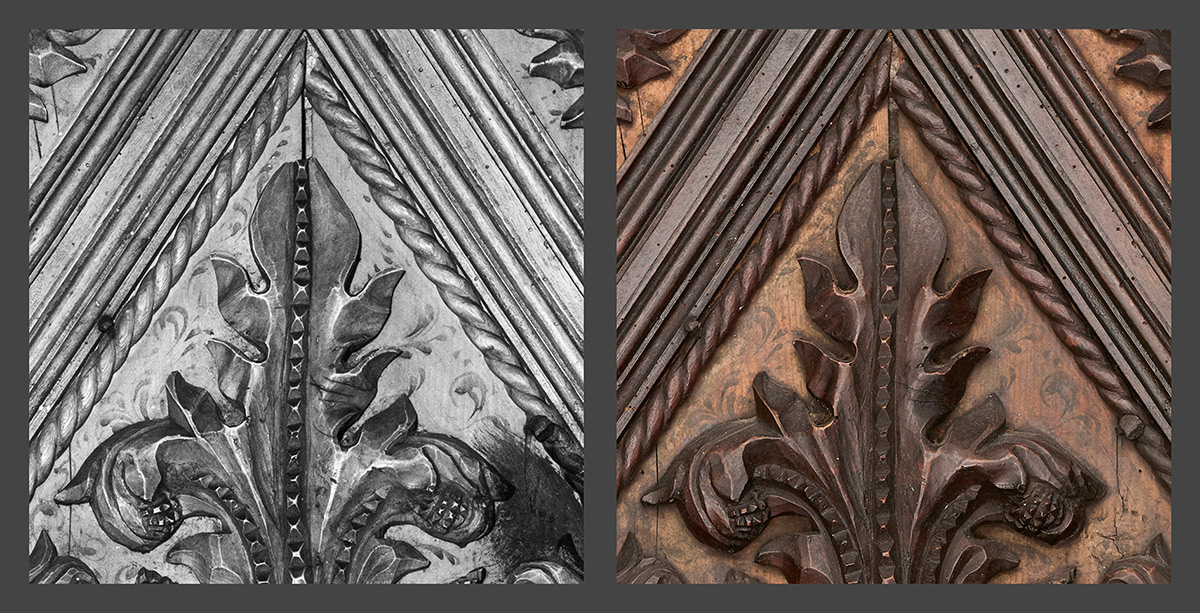
Conservation of choir seats
Parish church of the Assumption of the Blessed Virgin Mary was probably built as an early Christian church. It was thoroughly redesigned in the Romanesque style, and its façade is one of the most beautiful designs from the 12th century on the east coast of the Adriatic. Thanks to the centuries-old status of the Rab Cathedral, which it had until 1828 when the Dioceses of Rab and Osor were abolished and annexed to the Diocese of Krk, it is a real treasure trove of valuable works of art and relics.
Wooden choir seats, that are still used, were built in the sanctuary of the former Rab Cathedral during the first half of the 15th century. The backrests and partitions of the 32 seats are richly carved in the spirit of Venetian floral Gothic style. Another separate bench and the bishop's seat belong to the unit. The seats were ordered by members of the Nimir and Cernotta patrician families from Rab, whose carved coats of arms have been preserved under the relief of the Archangel Gabriel and the relief of the Virgin Mary. The chronogram MCCCCXLV indicates the year the work was completed, and the monogram MTVS ANT (or AVT) the master who made the benches. Due to the design similarities with the choir seats of the Zadar Cathedral, the work of the Venetian woodcarver Matej Moronzon, the benches are attributed to his opus.
Conservation of the benches began in 2018. Conservation research and review of archival material identified how the benches were made and the character of later renovations.
The original idea of the polychromator about the contrast between the parts of the benches painted in vivid colours with the colour and texture of wood was nullified by subsequently applied brown and black varnishing. Today, only fragments of the original painted layer remain, with the exception of surfaces hidden from view. A photograph of the back panel of the first seat of the north wing, made using infrared reflectography, revealed delicate vines beneath the dark varnishing, later mostly hidden by decorative carvings. This suggests the possibility that the benches were completed and painted months before decorative elements were added. Due to the fact that the south wing was not painted in the same way, it is possible that its production began later, and that the decorative elements were added immediately after they were built.
The quality of the renovation from the second half of the 17th century, when cabinets were added in the middle of both wings of the lower choir seats, stands out. When the cabinets were added, the carved ornaments had to be redrawn and moved. The replacement of the carved seat partitions with flat ones, as well as carved pinecones on top of the pillars with acorns was also part of that renovation. This renovation is a valuable example of the successful integration of new parts into an existing unit. It was concluded that subsequently applied varnishing would not be removed, but it was partially thinned on the flat surface of the backrest of the first seat of the north wing to present the original layer – vines with characteristic thickenings on leaf tips.
Weakened structural parts were strengthened during conservation and carpentry repairs. Missing decorative carvings were reconstructed out of wood based on models made of plasticine. They were then modified to fit the construction of the benches, and their colour was matched to the original. The bishop's seat was repaired by carpenters, and the missing part of the wooden support on the decorative shell was reconstructed in wood. The original carved fragments, later found in the church, were adapted to the decorative finish of the bishop's seat and modified to match the whole unit. The inadequately connected fallen and separated carved parts of the partition on the north bench were disassembled and returned to the correct position. Four carved planks, placed diagonally above the backs of the high seats of the south wing and the bishop's seat, were restored and returned to their original locations.
The work was completed in 2020 by experts from the Croatian Conservation Institute, adding one more valuable work of art to the corpus of restored Gothic wooden choir seats from churches on the Adriatic coast.

